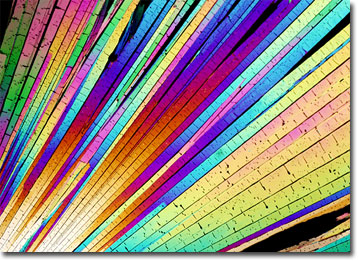Polarized Light Microscopy Digital Image Gallery
Para-Aminobenzoic Acid (PABA)
Para-aminobenzoic acid (PABA), which is a component of pteroylglutamate, was formerly believed to be a vitamin and was often referred to as vitamin B-X due to its role as a provitamin for some bacteria. However, studies over the last few decades have suggested that PABA does not demonstrate vitamin activity in humans because humans are unable to synthesize folate from the chemical.

View a second image of PABA
PABA occurs naturally in such items as mushrooms, bran, wheat germ, eggs, liver, molasses, brewer’s yeast, and yogurt. Yet, the substance is also marketed as a health supplement despite the fact that most scientists do not believe it is an essential part of the human diet. Many health food stores and other distributors of PABA claim that it is an effective treatment for vitiligo, which is a condition that is associated with the discoloration of the skin, and also link the chemical with hair growth and a reversal of the graying of hair. Others claim that PABA can improve the protein used in the body and may be helpful in connective tissue disorders. Nevertheless, little, if any, scientific evidence supports such assertions.
PABA has been most often utilized by humans as a component in sunscreens, successfully protecting the skin from harmful ultraviolet radiation. However, the frequent occurrence of PABA-related skin irritations has led many companies to introduce suntan oils and lotions that are PABA-free. Many people may also be familiar with ethyl-PABA, more commonly known as benzocaine, the key ingredient in many pain and itch relief ointments. In the chemical industry, PABA is utilized as an intermediate in the production of esters, folic acid, and other organic compounds.
